Practice DAT Exam 1 - Survey of Natural Sciences
1/66
Earn XP
Description and Tags
Biology, General Chemistry, & Organic Chemistry
Name | Mastery | Learn | Test | Matching | Spaced |
|---|
No study sessions yet.
67 Terms
During cell division, which of the following stages are most similar?
A. mitotic prophase and meiotic metaphase I
B. mitotic prophase and meiotic anaphase II
C. mitotic metaphase and meiotic metaphase I
D. mitotic metaphase and meiotic metaphase II
E. mitotic anaphase and meiotic anaphase I
D. mitotic metaphase and meiotic metaphase II | both stages involve a single-file line of chromosomes compromising two siser chromatics along the metaphase plate

During DNA replication, what prevents the separated strands from prematurely reattaching?
A. DNA ligase
B. DNA helicase
C. Topoisomerase
D. DNA sliding clamp
E. Single-stranded binding proteins
E. Single-stranded binding proteins | after DNA helices separates the DNA double helix, single-strand binding proteins attach to each strand of unzipped DNA in order to keep them separated and prevent both strands from snapping back together. Therefore, single-strand binding proteins help to maintain DNA in a single-stranded state, allowing DNA polymerase to synthesize new DNA
A. DNA ligase…joins DNA fragments together, creating continuous phosphodiester bonds between them; ex: during DNA replication, the lagging strand is composed of short segments known as Okazaki fragment, which are synthesize in a discontinuous manner. The enzyme DNA ligase joins these fragments together.
B. DNA helicase…is an enzyme that “unzips” the wound DNA double helix by breaking the H-bonds b/n complementary nitrogenous bases. Helicase separates the strands of a DNA double helix, but it does not maintain the single-stranded state
C. topoisomerase…as helices unzips the wound DNA double helix, it creates tension ahead of the replication fork as the strands separate (refer to as supercoiling). Topoisomerase creates small nicks within the DNA. double helix in order to relieve this tension.
D. DNA sliding clamp…sliding clamp proteins help DNA polymerase (the enzyme that adds new nucleotides) stay attached to the template strand.

Which of the following hormones can both constrict blood vessels and also dilate bronchioles?
A. Histamine
B. Angiostensin II
C. Nitric oxide
D. Epinephrine
E. Calcitonin
D. Epinephrine (commonly known as adrenaline)…is a “fight-or-flight” hormone released by the sympathetic nervous system); release results in:
constriction of certain blood vessels to reduce blood flow (e.g., blood vessels leading to the digestive system, which is not needed during fight-or-flight)
dilation of certain blood vessels to increase blood flow (e.g., blood vessels in skeletal muscle, which is essential during fight-or-flight)
stimulating bronchodilation (to help the body get more oxygen)
other fight-or-flight sympathetic responses, such as dilating pupils (to allow more light to hit the retina, providing more information about the environment)
A. histamine…if there’s an infection or allergic reaction, mast cells will release histamine, which dilates blood vessels—makes it easier for the immune system to reach the site of infection
B. angiotensin II… has many effects on the body. it is released when the body senses that it has lower blood pressure or blood volume
it’s a potent systemic vasoconstrictor—helps raise blood pressure
stimulates aldosterone release from the adrenal gland cortex—helps retain water and increase blood volume
increase Na+ reabsorption from the proximal tubule—helps retain water and increase blood volume
increases thirst
doesn’t have a direct effect on the bronchioles
C. nitric oxide…relaxes smooth muscles around surrounding blood vessels, leading to vasodilation
E. calcitonin..thyroid hormone that works to decrease blood calcium levels. it inhibit osteoclasts from breaking down bone and stimulates calcium excretion via the kidneys
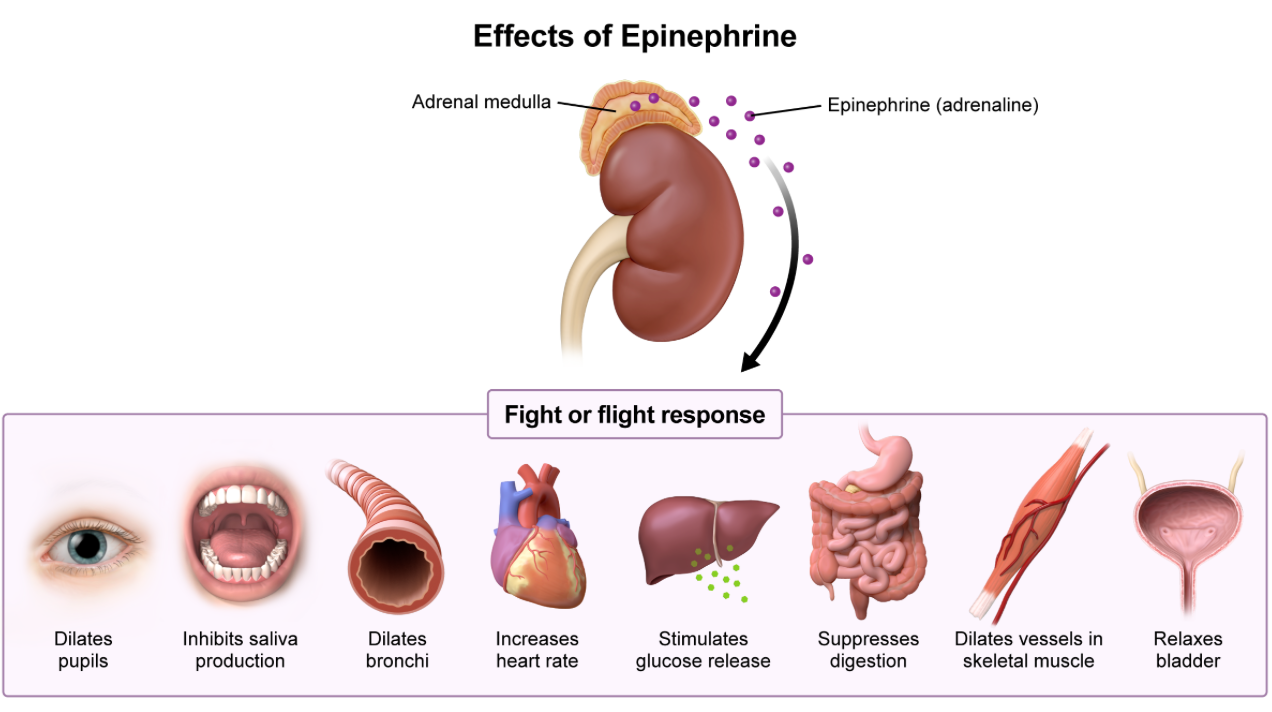
In an ecological community, leopards and tigers compete for warthogs as a food source. A sudden growth in the leopard population causes a depletion of warthogs. What is this an example of?
A. resource partitioning
B. exploitation competition
C. apparent competition
D. intraspecific competition
B. exploitation competition | indirect competition that occurs when a shared resource like territory, prey, or food is depleted;
C. apparent competition is indirect competition, where the growth of one species leads to a decline in anode because of a shared predator
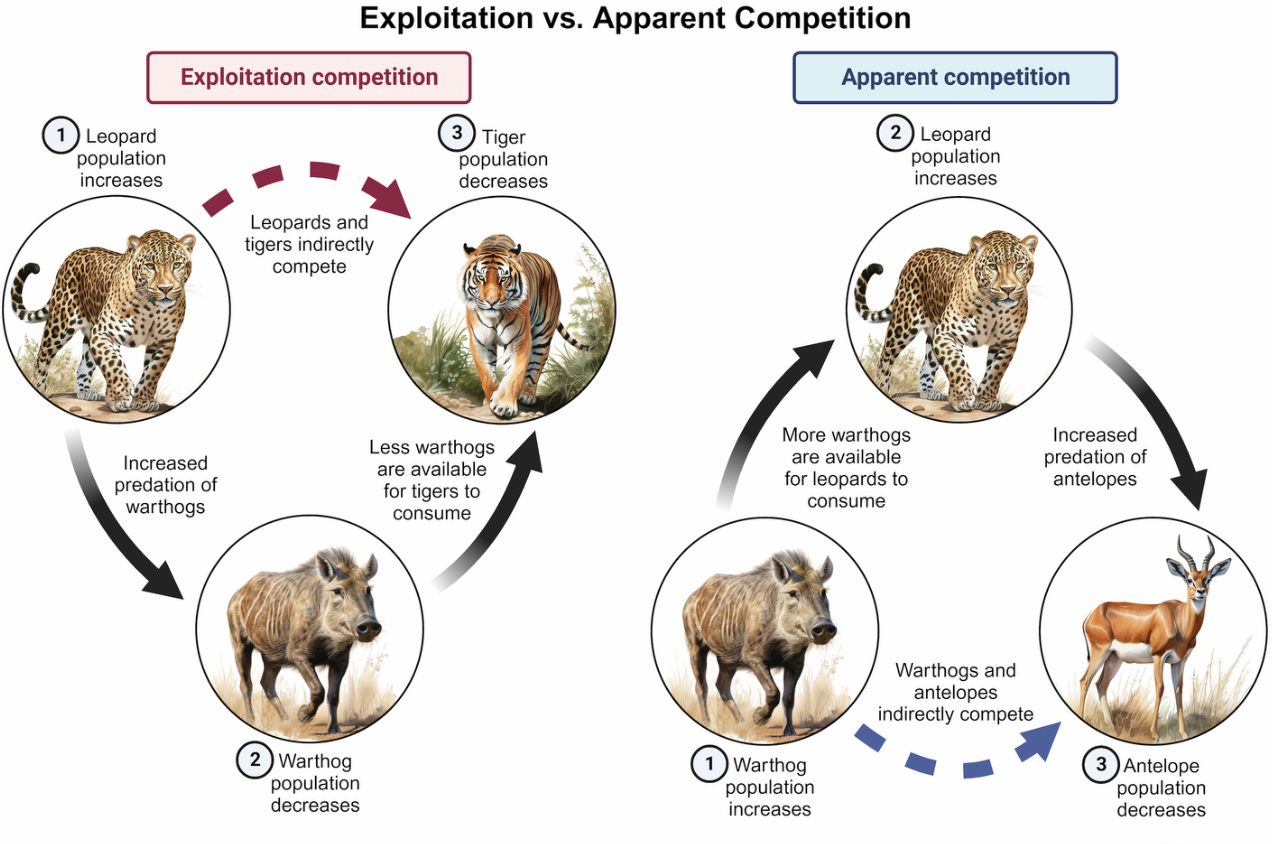
In which part of the cell would you find enzymes associated with glycolysis?
A. golgi
B. nucleus
C. cytoplasm
D. cell membrane
E. mitochondria
C. cytoplasm | glycolysis occurs within a cell’s cytoplasm. in eukaryotes, the pyruvate and NADH products of glycolysis are then shuttled into he mitochondria for further metabolic reactions
DAT Pro-Tip: In prokaryotes, the pyruvate manipulations and Krebs cycle occur in the cytosol, and the ETC occurs along the cellular membrane. This is bc prokaryotes don’t have mitochondria (or other membrane-bound organelles).
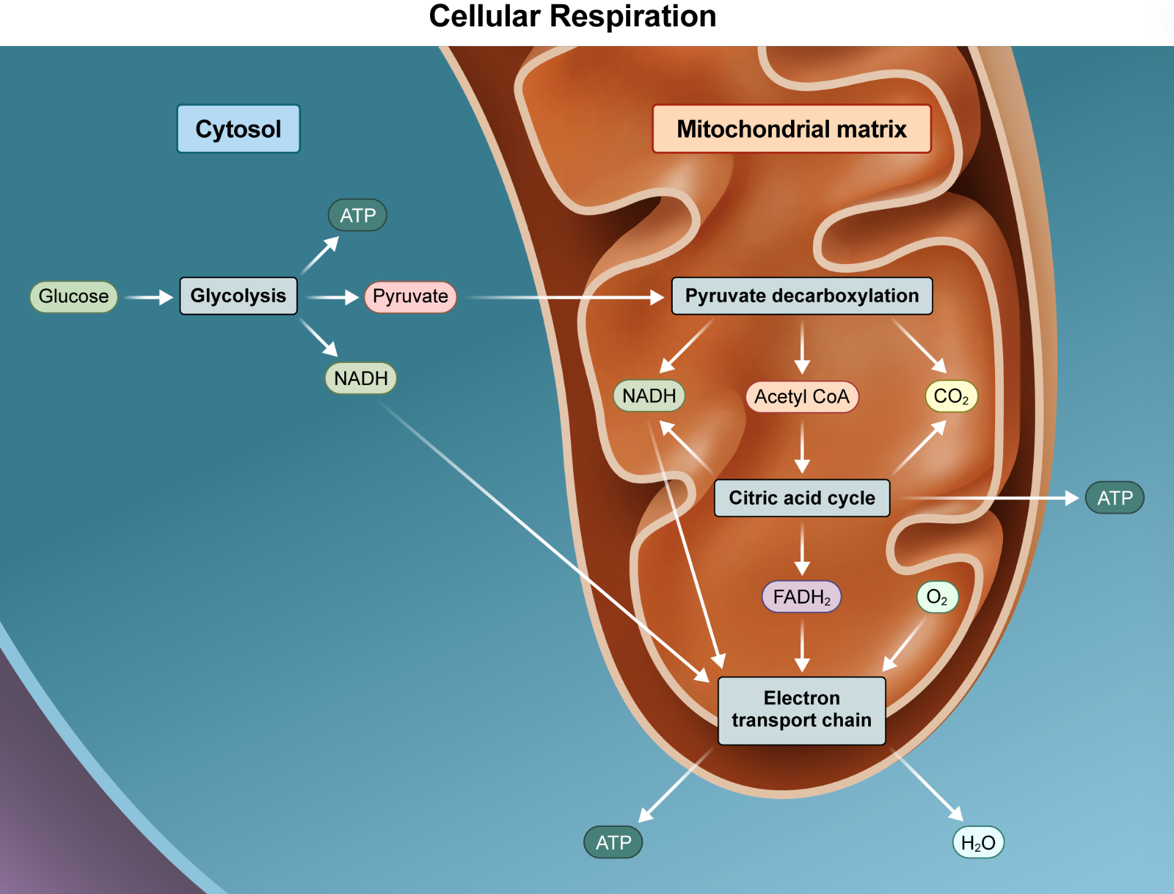
A cell from a sheep embryo’s spine was removed and then placed onto its leg region. This results in the surrounding stem cells of that region differentiating into a vertebral column. What term best describes this phenomenon?
A. apoptosis
B. induction
C. gastrulation
D. conjugation
E. transduction
B. induction | describes the embryonic process in which one group of cells influences the differentiation of neighboring immature cells. cells capable of directing the developmental fate of neighboring embryonic cells are known as organizers. Organizers release signaling molecules that initiate gene expression patterns in the recipient cells, directing them to differentiate into specific cell types
—
A. apoptosis is programmed cells death mechanism that removes damaged or unnecessary cells without causing harm to the surrounding tissue
C. gastrulation is a stage of early embryonic development in which a blastula develops into a gastrula, forming 3 embryonic germ layers: ectoderm, mesoderm, and endoderm
D/E…conjugation and transduction are forms of horizontal gene transfer in bacteria;
transformation occurs when a cell uptakes and incorporate extracellular DNA. bacteria that are able to perform transformation are known as competent bacteria
conjugation is a method of horizontal gene transfer in bacteria where one bacterium transfers DNA directly to another through a pilus bridge
transduction is a method of HGT in bacteria where a bacteriophage (a type of virus that infects bacteria) carries bacterial DNA from one bacterial cell to another
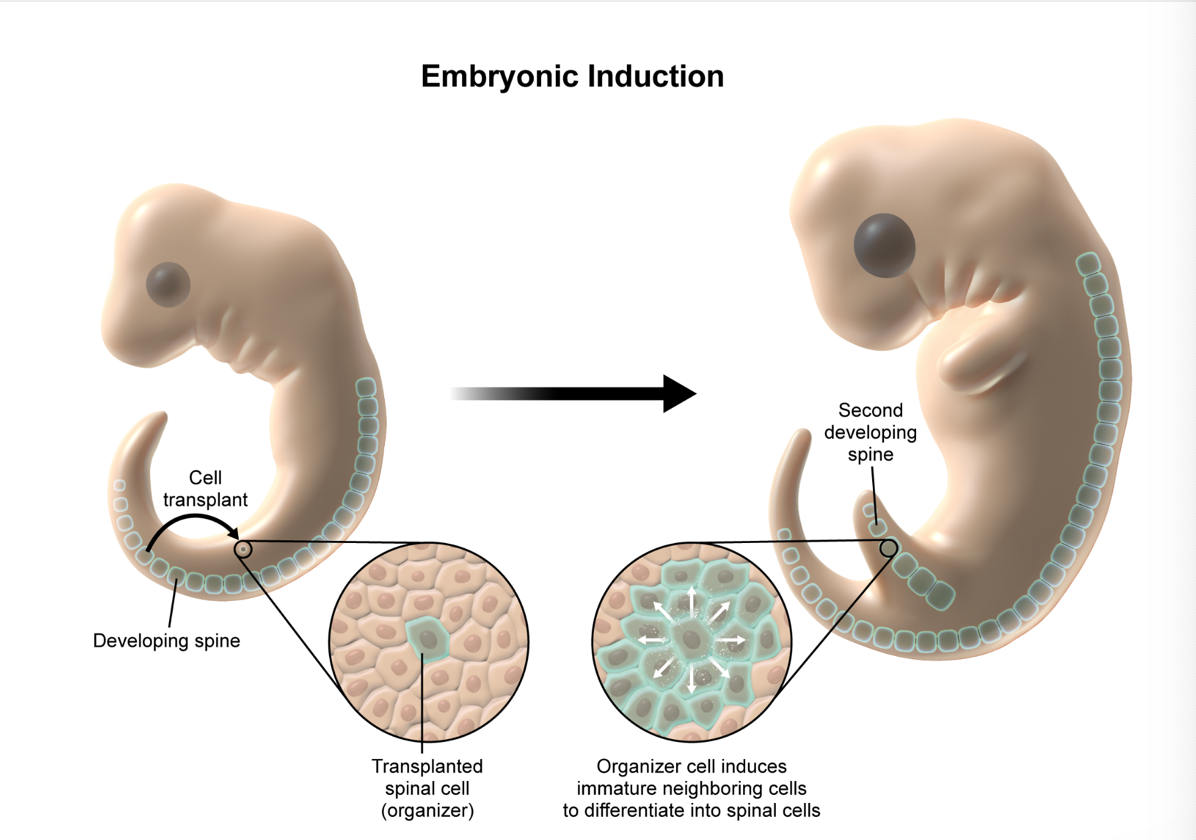
Which of the following stimulates parietal and chief cells to release digestive enzymes?
A. secretin
B. gastrin
C. chymotrypsin
D. bile
E. amylase
B. gastrin | When a food bolus reaches the stomach, the resulting distension stimulates G cells to release gastrin. gastrin is a hormone with two main functions:
stimulates parietal cells in the stomach to release gastric juice (gastric juice is why the pH of the stomach is acidic)
stimulates chief cells in the stomach to secrete gastric lipase and pepsinogen, which are digestive enzymes
gastric lipase breaks down fats
pepsinogen is a zymogen (i.e., inactive) form of pepsin, a protease (i.e., it breaks down proteins). once release into the topic, pepsinogen is converted into pepsin by the hydrochloric acid (HCl) found in gastric juice
A. secretin…hormone released by the small intestine in response to the presence of chyme. its primary function is to stimulate the pancreas to secrete bicarbonate ions, which help neutralize acidic chyme in the duodenum
C. chymotrypsin..the pancreas produces and secretes chymotrypsinogen, which is activated into chymotrypsin by trypsin in the small intestine. both trypsin and chymotrypsin are proteases
D. bile…is a fluid produced by the liver and stored in the gallbladder; it emulsifies fats for digestion. Cholecystokinin (CCK) is produced by the small intestine and prompts the gallbladder to release bile, along with stimulation the pancreas to secrete digestive enzymes
E. amylase…two types of amylases: salivary (secreted by the salivary glands in the mouth) and pancreatic (secreted by the pancreas. breaks down carbohydrates like starch into simpler sugars
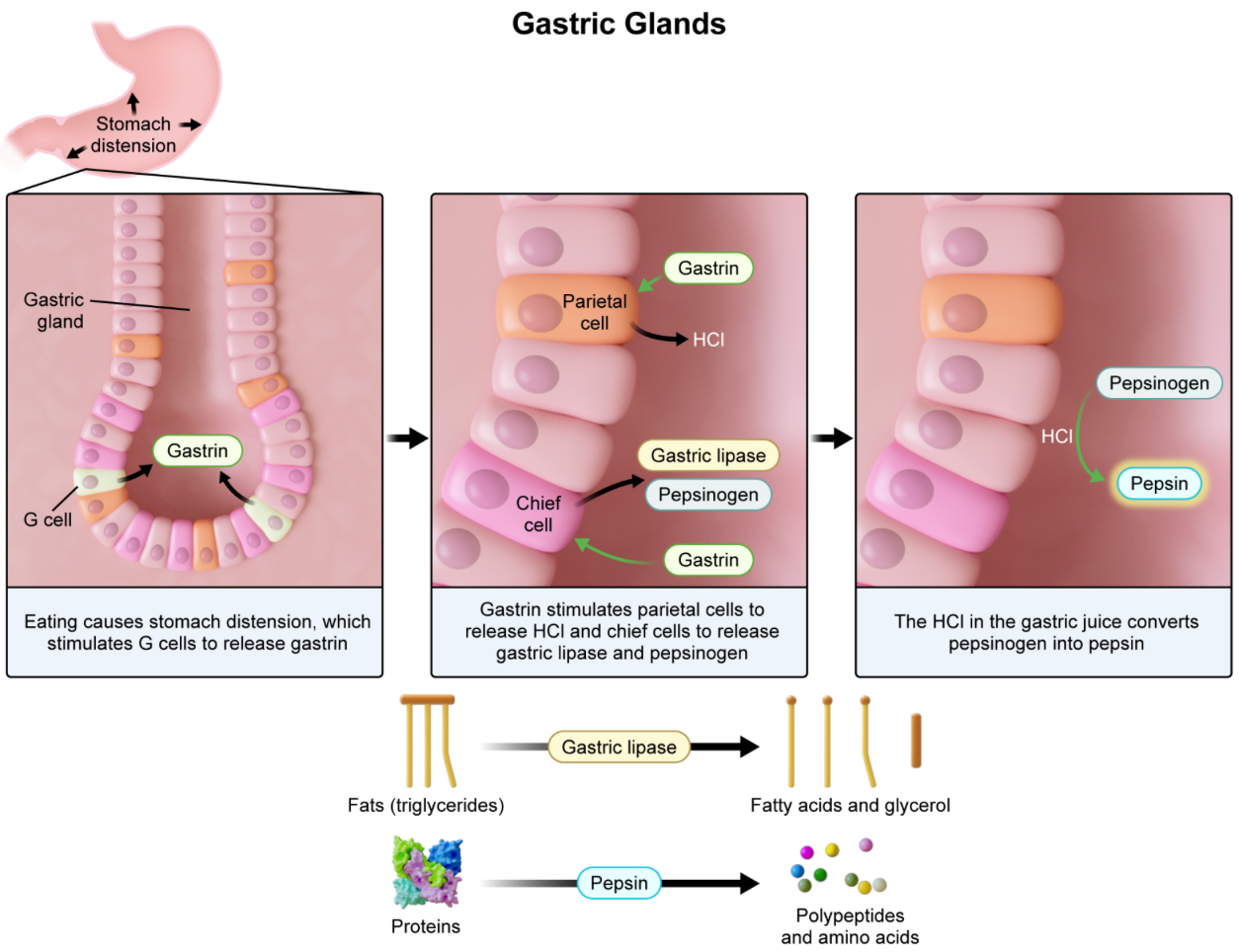
Which of the following types of mutations is required for a proto-oncogene to become cancerous?
A. one-hit, loss-of-function mutation
B. two-hit, loss-of-function mutation
C. one-hit, gain-of-function mutation
D. two-hit, gain-of-function mutation
C. one-hit, gain-of-function mutation | meaning a gain-of-function mutation in one copy of the gene is all that is required to turn the gene into a cancer-causing oncogene.
Key Takeaways
proton-oncogenes become cancerous via a one-hit, gain-of-funtion mutation ; tumor-suppressor genes become cancerous via a two-hit, loss-of-function mutation
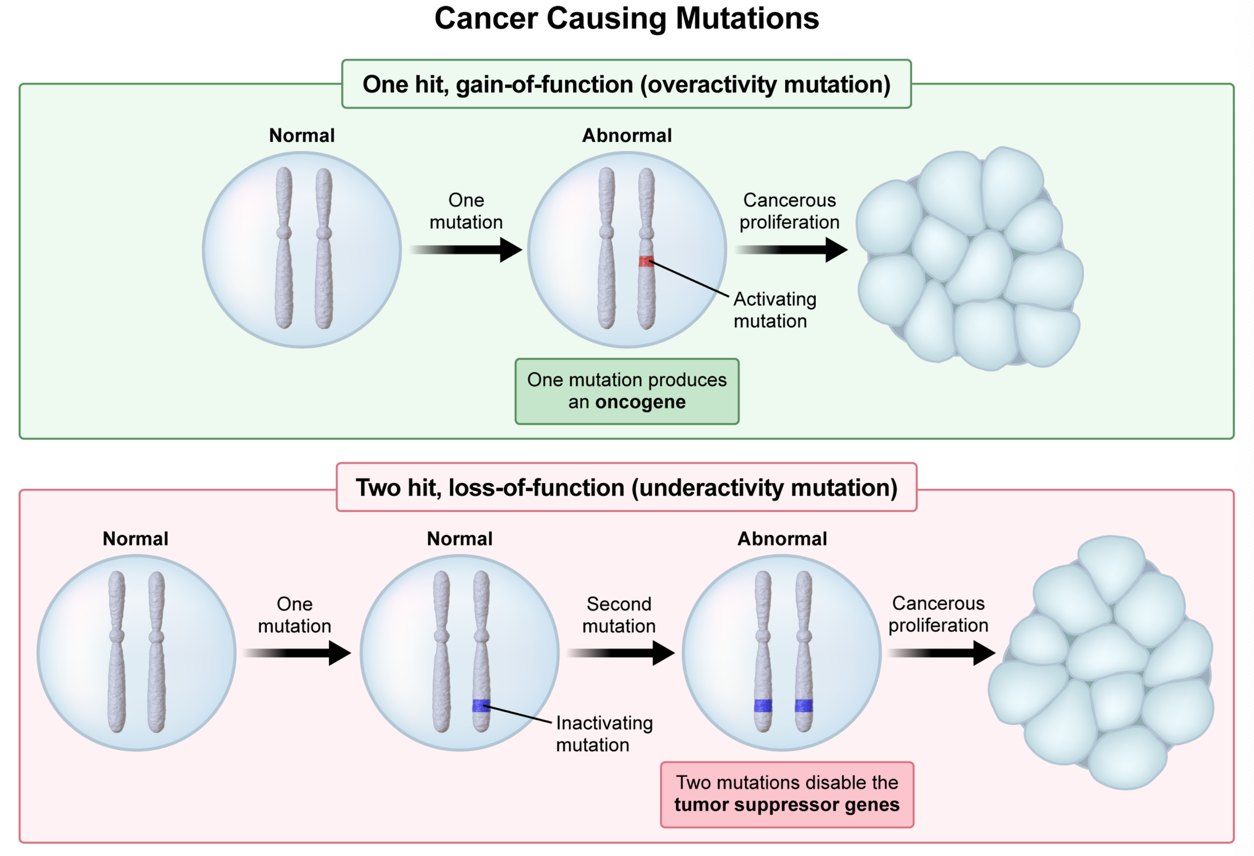
What are the major forces that hold the lipid bilayer together?
A. electrostatic interaction and surface tension
B. disulfide bonds and ionic bonding
C. peptide bonds and van der Waals forces
D. hydrophobic interactions and van der Waals forces
E, ionic bonding and hydrogen bonding
D. hydrophobic interactions and van der Waals forces | the major force driving the formation of the phospholipid bilayer is hydrophobic interactions—vdW helps maintain structure
Key Takeaway:
the major forces the major force driving the formation of the phospholipid bilayer are hydrophobic interactions and vdW forces
phosphate head groups are hydrophilic; fatty acid tails are hydrophobic
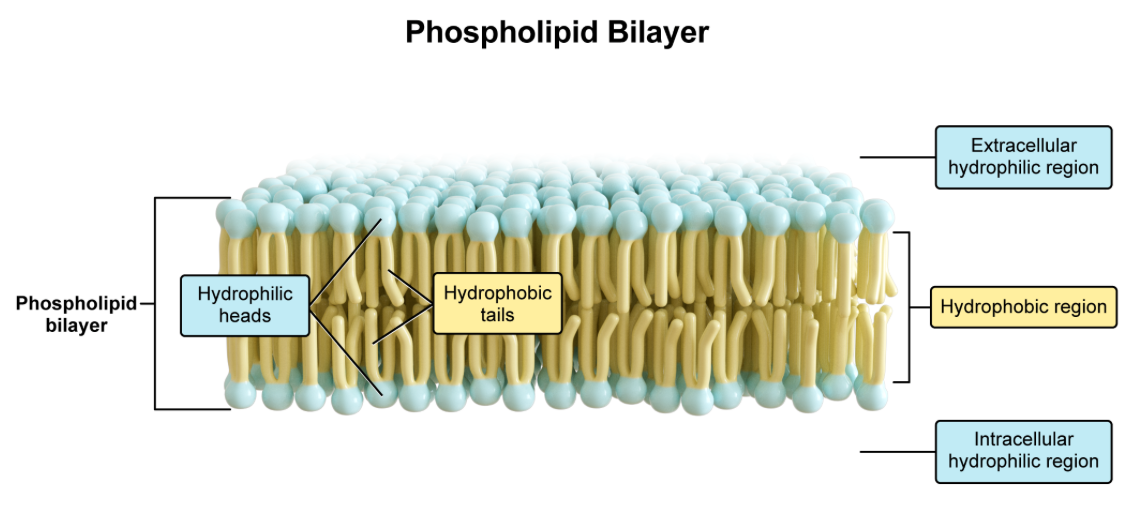
A scientist is researching a unicellular organism. The presence of which of the following features would help determine whether the organism is an archaea or bacteria?
A. plastids
B. nucleus
C. peptidoglycan
D. ribosomes
E. binary fission
C. peptidoglycan | cells walls of bacteria contain peptidoglycan — those of archaea do not
A. plastids are double-membranes organelles found within plant cells (e.g., chloroplasts). neither bacteria not archaea contain membrane-bound organelles, so this wouldn’t be a way to differentiate them. plastics would be an effective way to differentiate plant cells from animal cells.
B. nucleus…both bacteria and Arachne lack membrane-bound organelles
D. ribosomes…both bacteria and archaea have 70S ribosomes used in protein synthesis
E. binary fission…both bacteria and archaea undergo this
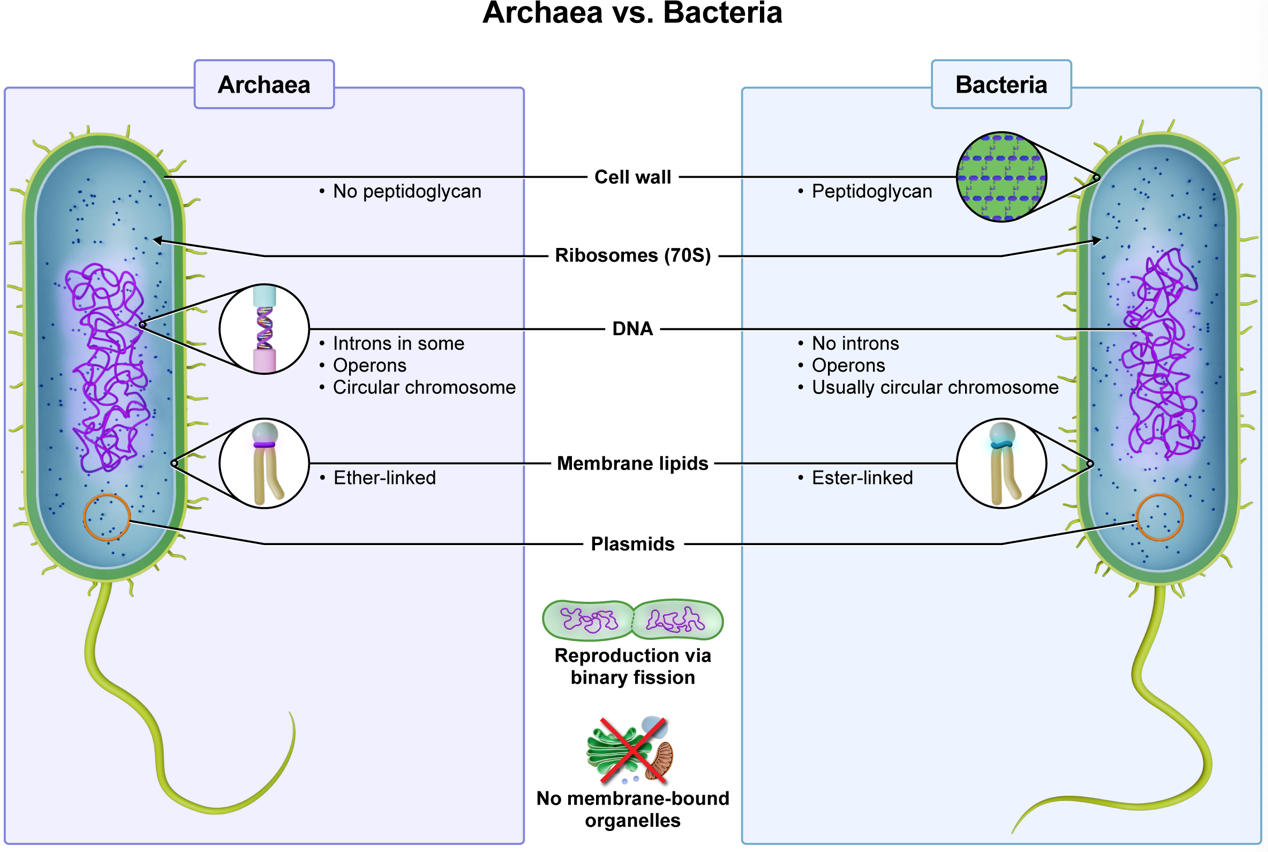
Red-bellied male stickleback fish exhibit a series of innate, aggressive behaviors to protect their property against other red-bellied sticklebacks. Once initiated, this behavior continues until complete. What is this an example of?
A. taxis
B. fixed action pattern
c. imprinting
D. classical conditioning
E. reflex
B. fixed action pattern | instinctive behavioral sequence that continues to completion in response to a specific stimulus (called the releaser/sign stimulus) Fixed action patterns are considered the simplest for of an instinct

Which of the following indicates the presence of a competitive inhibitor?
A. Km increases
B. Km decreases
C. Vmax increases
D. Vmax decreases
A. Km increases | Km is the Michaelis Constant —the substrate concentration [X] at which the velocity (V) of a reaction is 50% of the maximum reaction velocity (Vmax).
in competitive inhibition, inhibitors compete with substrates for active sites
in an enzyme kinetic plot, a competitive inhibitor causes Km to increase and Vmax to stay the same
![<p><strong>A. K<sub>m</sub> increases | K<sub>m</sub> is the Michaelis Constant —the substrate concentration [X] at which the velocity (V) of a reaction is 50% of the maximum reaction velocity (V<sub>max</sub>).</strong></p><ul><li><p>in competitive inhibition, inhibitors compete with substrates for active sites</p></li><li><p>in an enzyme kinetic plot, a competitive inhibitor causes K<sub>m</sub> to increase and V<sub>max</sub> to stay the same</p></li></ul><p></p>](https://knowt-user-attachments.s3.amazonaws.com/f6117a3c-74b1-4eac-918f-2abc6792fc57.png)
A man with blood type AB- received a blood transfusion with type A- blood. Which of the following is most likely to occur after the transfusion?
A. The immune system responds to the presence of B antigen
B. The immune system responds to the presence of A antigen
C. The immune system responds to the presence of Rh factor
D. The immune system does not respond
D. The immune system does not respond | the immune system attacks foreign blood antigens; blood type AB- would only produce antibodies against (+) blood transfusions
—
An individual with AB blood type crosses both A and B antigens on their erythrocytes (red blood cells), allowing them to receive transfusions of A, B, or AB blood types w/o provoking an immune reaction.

Which of the following describes how dizygotic twins are formed?
A. one zygote divides to form two embryos
B. two eggs are fertilized by two different sperm
C. one sperm fertilizes two different eggs
D. indeterminate cleavage of the embryo
E. two seem fertilize the same egg
B. two eggs are fertilized by two different sperm |
monozygotic (identical) twins are formed when one zygote divided to form two embryos
dizygotic (fraternal) twins are formed when two separate eggs are fertilized by two different sperm
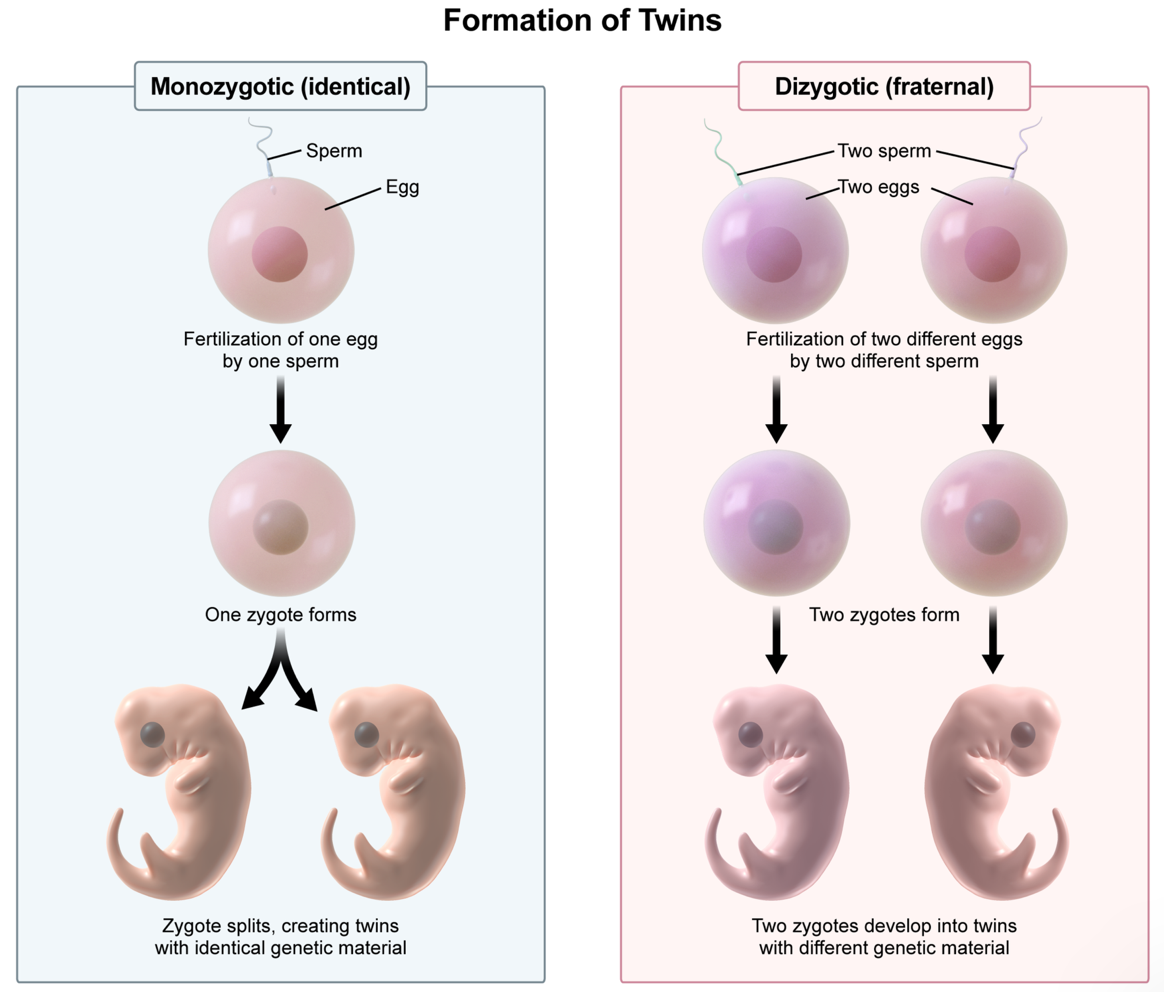
Which of the following results in an increase in eukaryotic gene expression?
A. DNA methylation
B. heterochromatin packaging
C. histone acetylation
D. histone deacetylation
E. point mutation in a stop codon
C. histone acetylation | an epigenetic tic modification in which acetyl groups are added to histones. the acetyl groups neutralize the positive charge of the histones, relaxing the electrostatic interactions between the histones and DNA; the relaxation forms euchromatin, a loosely packed form of chromatin that’s easily accessed by transcription factors. the formation of euchromatin ultimately increases gene expression
Key Takeaway:
eukaryotic DNA is wrapped around histones with varying degrees of tightness
modifications that relax the electrostatic interactions between/n DNA and histones will increase gene expression
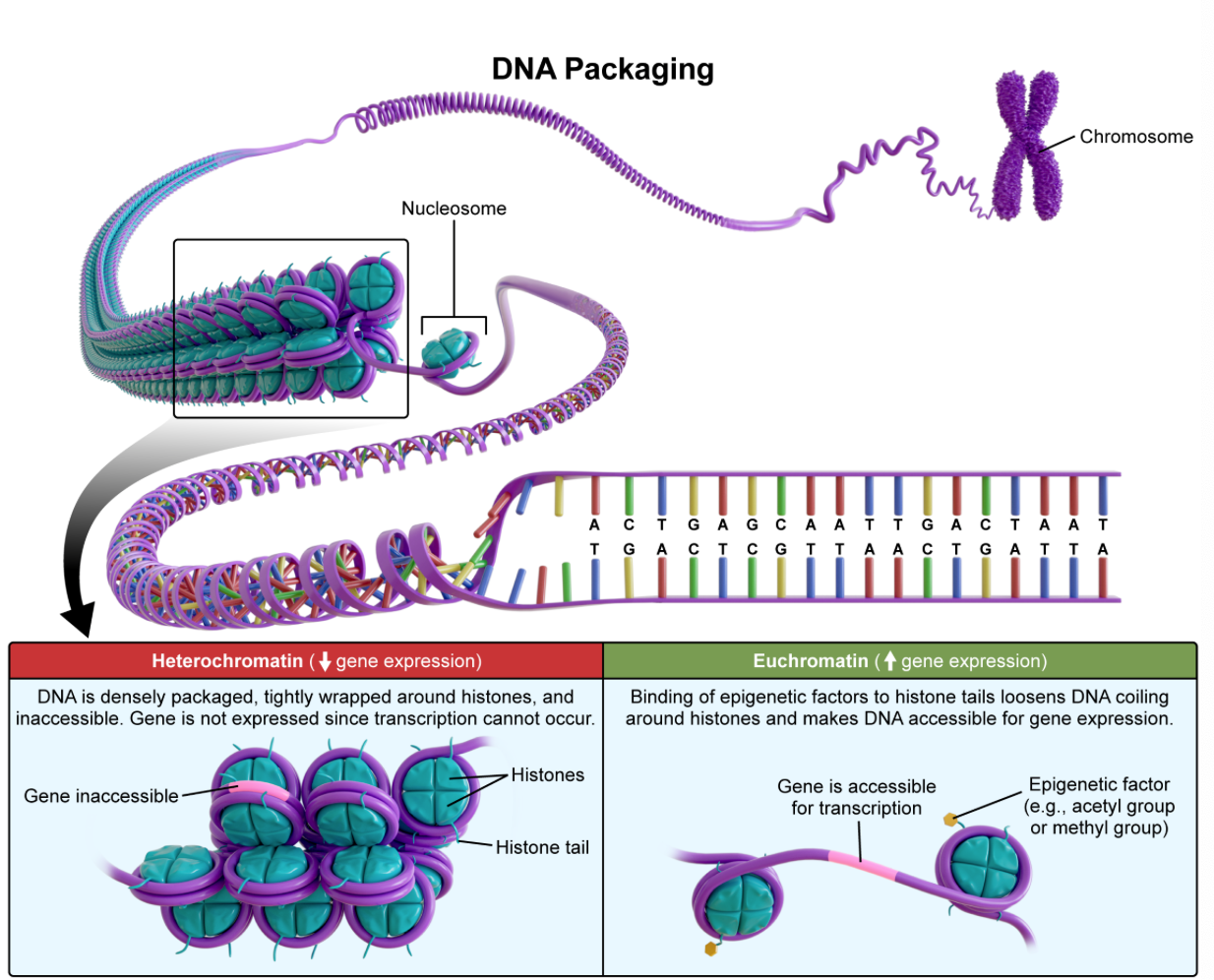
what is the main advantage of internal fertilization compared to external fertilization?
don’t need to find mates
doesn't require anatomical compatible reproductive organs
increased genetic diversity
requires fewer gametes
produces more offspring
requires fewer gametes…bc the male directly deposits sperm into the female’s body
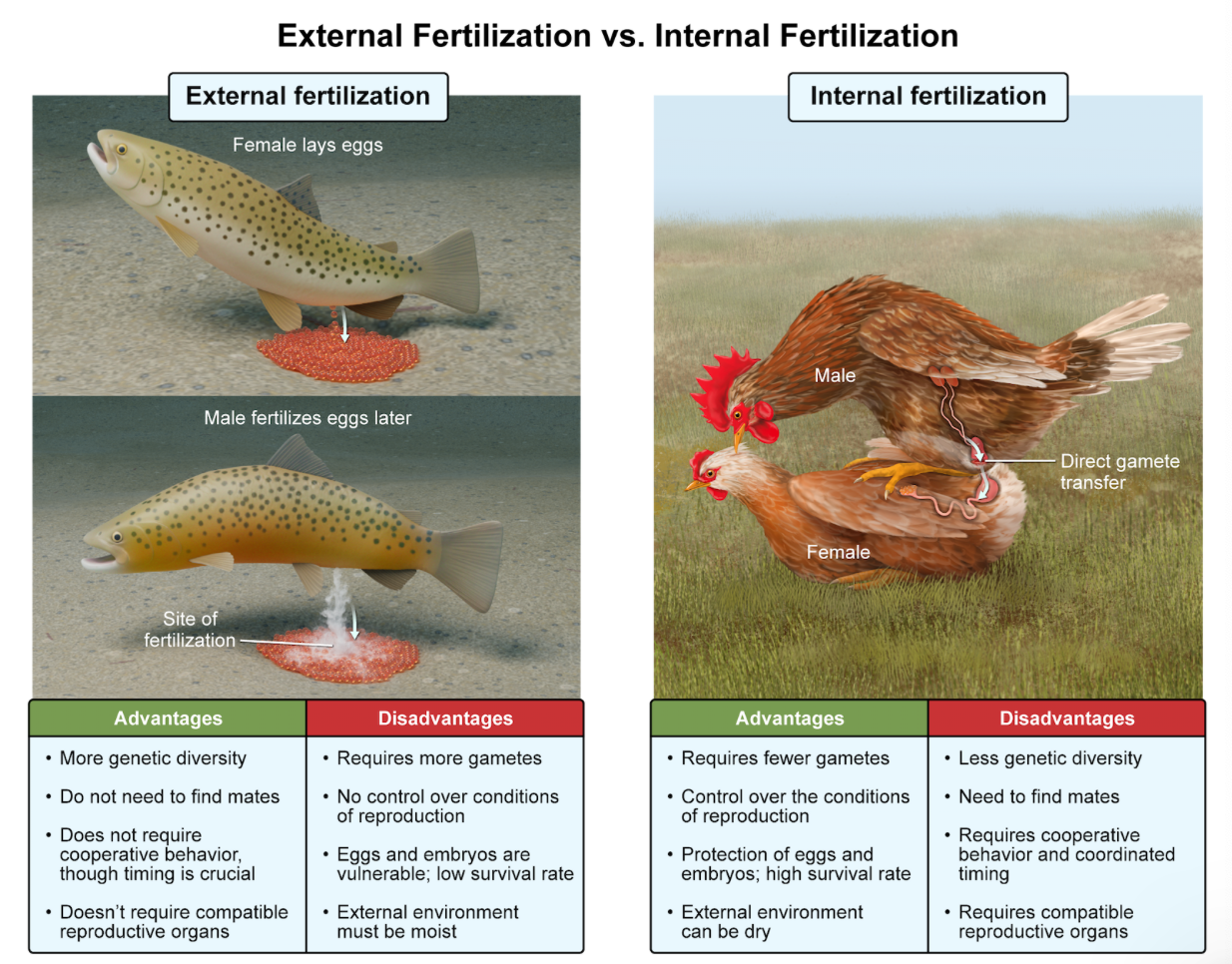
A researcher extracts DNA from a host cell, restriction enzymes are used to cut the DNA into fragments and integrate it into plasmids, the plasmids are taken up by bacteria, and the genome is analyzed. What is this process called?
dna fingerprinting
ELISA
genomic library construction
SDS-PAGE
genomic library construction | collection of the total genomic DNA from a single organism; involves: extracting DNA from a host cell, then using restriction enzymes to cut the DNA, and the inserting the DNA fragments into plasmid vectors, and finally inserting the plasmids into bacteria for analysis

By which mechanism do crassulacean acid metabolism (CAM) plants reduce photorespiration in hot environments?
C2 photosynthesis
cyclic photophosphorylation
spatial isolation
temporal isolation
temporal isolation | to prevent water loss in hot environments, crassulacean acid metabolism (CAM) plants close their stomata during the day and open their stomata at night (temporal isolation)
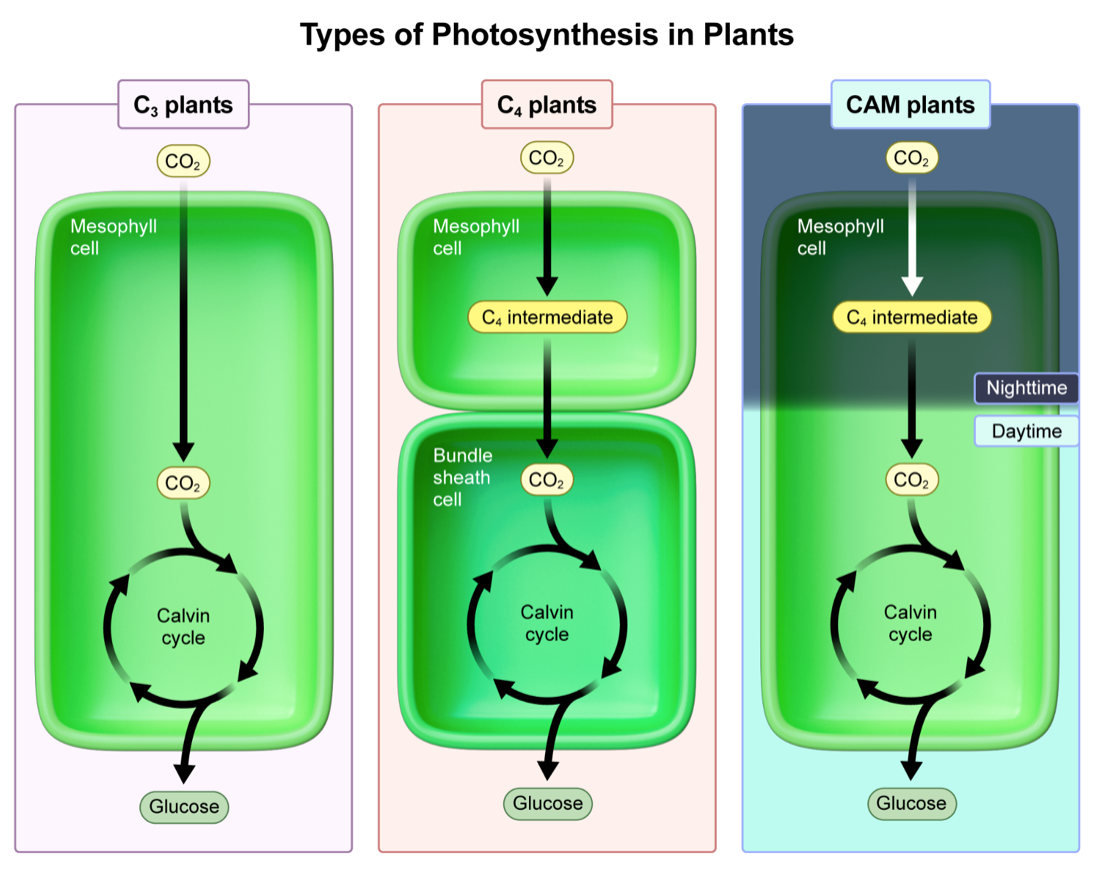
If missing, which of the following would prevent DNA transcription from occurring?
ribosome
RNA polymerase
tRNA
DNA polymerase
rRNA
RNA polymerase | synthesizes mRNA from a DNA template; three steps in transcription:
initiation: promoter sequence next to the gene attracts RNA polymerase to transcribe the gene
elongation: a transcription bubble forms; RNA polymerase synthesizes mRNA in the 5’—>3’ direction
termination: termination sequence (terminator) signals RNA polymerase to stop transcribing the gene
mRNA is then translated into a protein by ribosomes
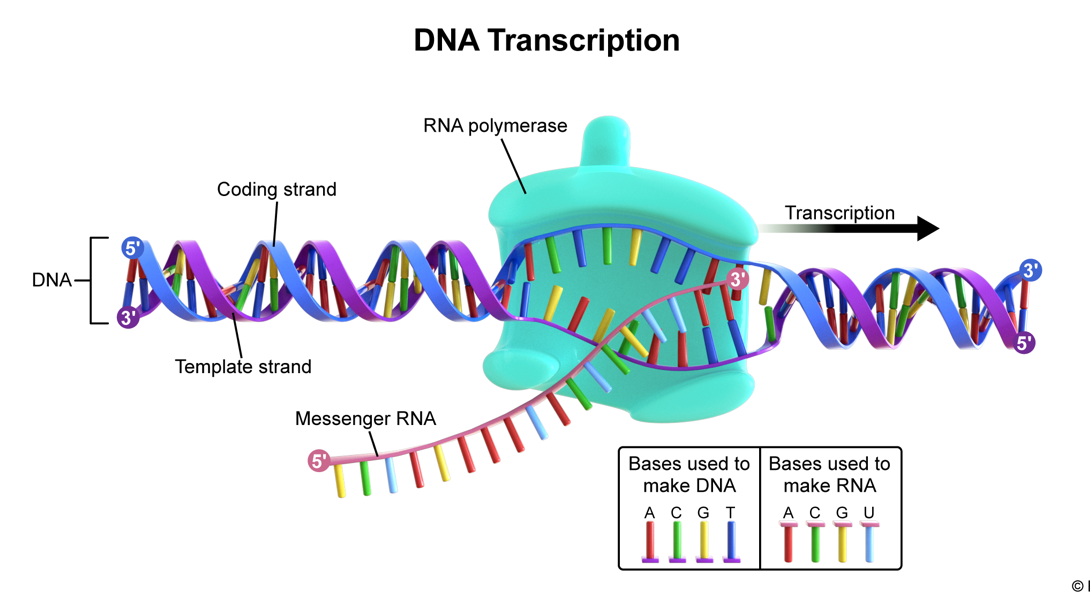
In which part of the circulatory system would the most deoxygenated blood be found?
aorta
pulmonary artery
pulmonary vein
capillary
arteriole
pulmonary arteries are the final cells before blood reaches the luns and is reoxygenated;
pulmonary veins contain the most oxygenated blood, as they are the blood vessels that blood travels through directly after the lungs
A mutation that inactivated which of the following cells would result in a lack of antibodies?
mast cells
B cells
T cells
monocytes
neutrophils
B cells | In adaptive immunity, B cells are responsible for antibody-mediated immunity (also called humoral immunity). Plasma cells are differentiated forms of B cells that produce and secrete antibodies.
—
A. Mast cells—type of leukocyte found in tissues. When body tissue is injured, mast cells release histamine. Histamine has two main functions:
Dilate nearby capillaries → blood flow increases.
Make capillary walls more permeable → fluid and immune cells leak out of blood vessels and into the site of injury.
C. T cells—responsible for cell-mediated immunity; can differentiate into CD4 or CD8 T cells.
CD4 T cells: These cells result from antigen presentation by MHC II molecules and are also known as helper T cells. These cells attract innate immune cells and stimulate clonal selection and proliferation of B cells and T cells.
CD8 T cells: These cells result from antigen presentation by MHC I molecules and are also known as cytotoxic T cells. These cells recognize and kill infected or cancerous cells.
D. Monocytes—part of the innate response; called monocytes when they are in their immature state in the blood vessels. After they cross into the infected tissue through diapedesis, monocytes mature into phagocytic macrophages.
E. Neutrophils—part of the innate response; are phagocytes and the most common type of leukocyte; the first leukocytes to respond to inflammation.
—
B cells produce antibodies as part of antibody-mediated (humoral) immunity.
T cells are involved in cell-mediated immunity through the direct attack of infected cells.
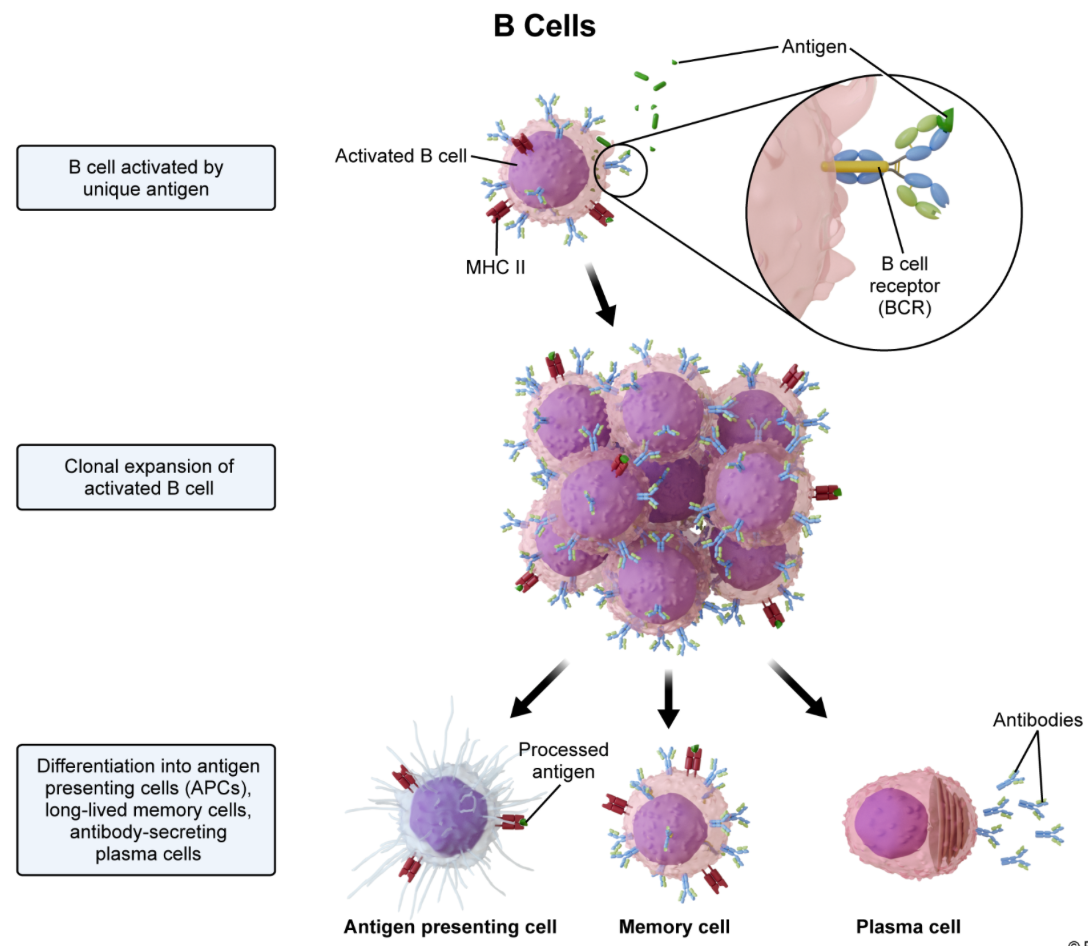
If actin microfilaments are inhibited from forming, which of the following would most likely be observed in the cell?
cell would be unable to cleave
cell would be unable to absorb nutrients
cell membrane would break down
cell would be unaware to adhere to surfaces
cell would be unable to cleave | In animal cells, cytokinesis begins with the formation of a cleavage furrow. The cleavage furrow is a contractile ring composed of actin microfilaments and myosin motors; it functions to pinch the cell into two
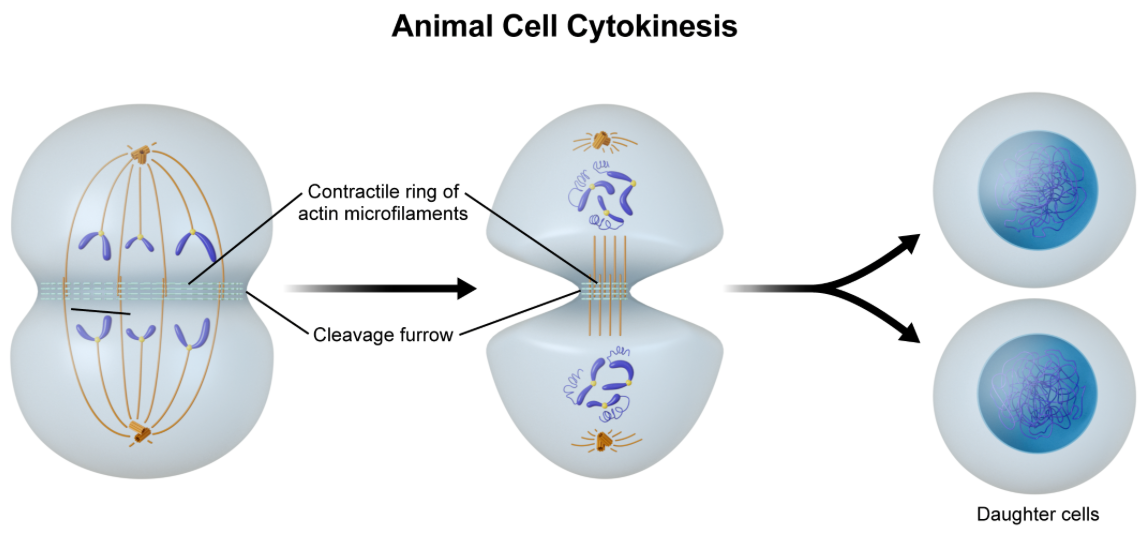
At what point during the cell cycle does DNA replication occur?
G0 phase
G1 phase
G2 phase
S phase
M phase
S phase | stage where DNA synthesis (or replication) occurs. centrosomes are also replicated in the S phase

If nondisjunction occurs during the first meiotic division of a human oocyte, what are the possible number of chromosomes in the resulting zygote after this oocyte is fertilized?
22,24
22,23,24
45,47
45,46,47
90,92,94
45,47 | 2×(23)±1=45, 47 ; nondisjunction is when chromosomes fail to separate properly during cell division; when nondisjunction occurs in meiosis I, the gametes affected will end up with either n+1 or n-1 chromosomes
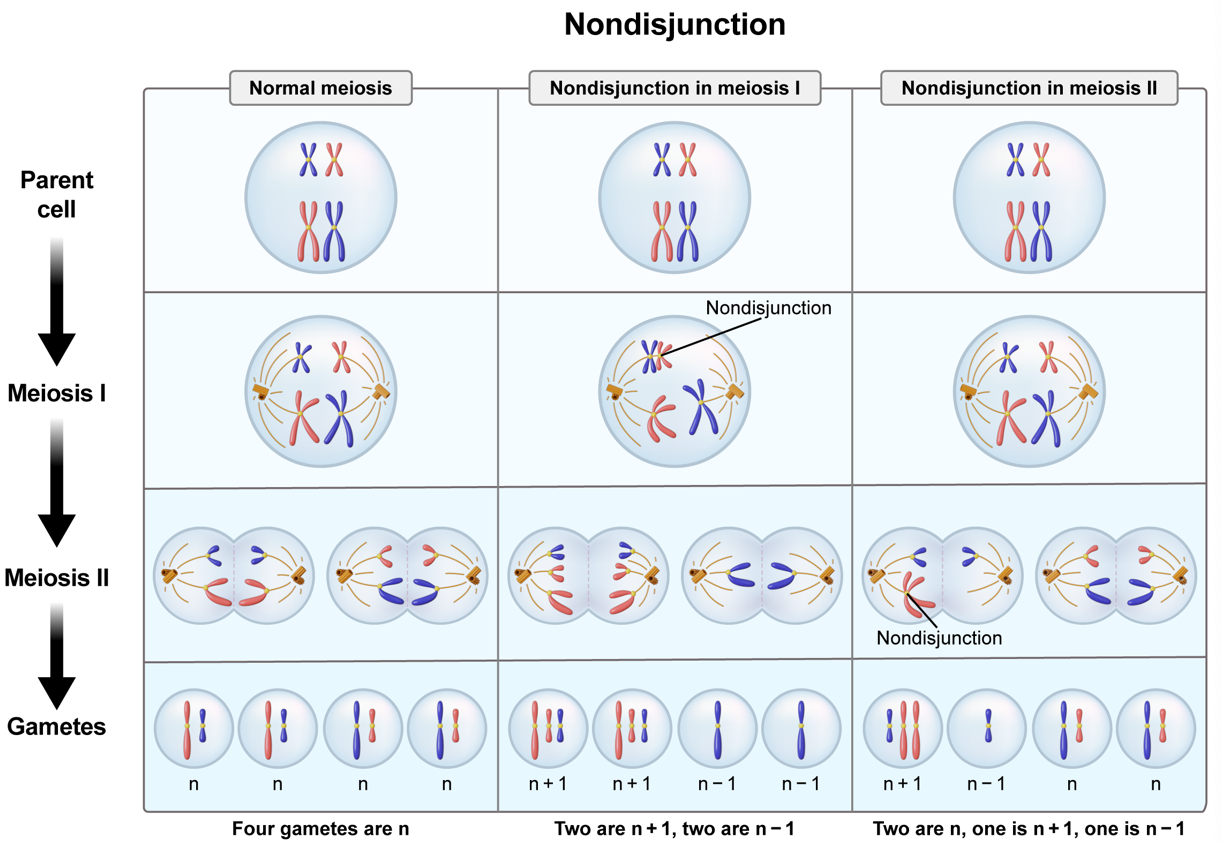
Snake venom binds to and irreversibly inactivates acetylcholine in the synapse. Which of the following is an expected result of the venom?
presynaptic cell increases Ca2+ reuptake
postsynaptic cell will hyperpolarize
postsynaptic cell will not depolarize
postsynaptic cell with contract uncontrollably
postsynaptic cell will not depolarize
acetylcholine is released from the presynaptic motor neuron onto the muscle fiber, stimulating contraction
if toxins(snake venom) irreversibly bind to and inactivate acetylcholine, the postsynaptic cell will fail to depolarize and contract
Embryonic mesoderm gives rise to which of the following structures in humans?
brain
skeletal muscle
epidermis
sweat glands
lining of the bladder
skeletal muscles—derived from the embryonic mesoderm
A population is in Hardy-Weinberg equilibrium for alleles B (dominant) and b (recessive). If 9% of the population is homozygous recessive for the allele, what percentage of the population is heterozygous for that allele?
21%
30%
42%
70%
91%
42%
Key Takeaway:
In the equation p + q = 1:
p represents the frequency of the dominant allele in the population.
q represents the frequency of the recessive allele in the population.
In the equation p2 + 2pq + q2 = 1:
p2 represents the frequency of homozygous dominant individuals.
2pq represents the frequency of heterozygous individuals.
q2 represents the frequency of homozygous recessive individuals.
The human arm and a bat's wing contain the same bones, but in different sizes and shapes. It’s hypothesized both evolved from a single ancestor that shared these bones. What is this an example of?
parallel evolution
coevolution
divergent evolution
convergent evolution
directional selection
divergent evolution—occurs when two species with a common ancestor evolve different traits, often in response to different environmental conditions or niches

A farmer has two true-breeding apples: one dominant and one recessive. The color red is dominant and the spotted skin appearance is recessive. The farmer crosses the two apples to create F1 and all the apples are red. One of the F1 apples is then crossed with a spotted apple. What is the ratio of red to spotted apples in F2?
4:0
3:1
1:1
0:4
1:1
—
The parental generation of apples is true-breeding. True-breeding organisms are homozygous for all the genes of interest related to a given phenotype.
Use R to represent red color (dominant) and r to represent spotted appearance (recessive). The true-breeding dominant and recessive parents would be RR and rr, respectively. When crossed, all of the F1 generation is Rr.
Next, one of the F1 apples (Rr) is crossed with a spotted apple (rr), resulting in two red apples (Rr) and two spotted apples (rr). This results in a phenotypic ratio of 1 red : 1 spotted apple.
Key Takeaway:
True-breeding organisms are homozygous for all the genes of interest related to a given phenotype.
Dominant alleles will mask the expression of recessive alleles.